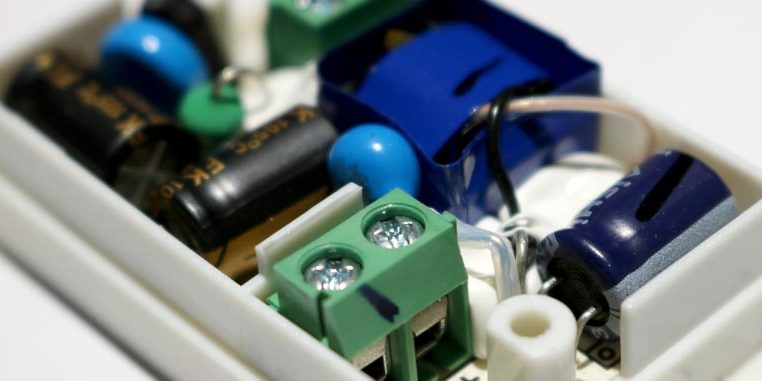Generally, we can say that LEDs are environmentally friendly and recyclable. They have a long lifetime and low power consumption. They don’t contain hazardous substances, for example, mercury as compact fluorescent lamps do. In this blog post, I will present to you four environmentally friendly luminaire component choices.
LED That Don’t Need a Driver

Have you ever looked inside the driver? In the picture above, you can see the inside of the small-sized one. Drivers are made of many different materials and components. That’s why they are hard to recycle. The fewer components product has, the easier it is to recycle. For example, an aluminium heatsink is easy to recycle, because it contains mainly aluminium.
Drivers are the most fragile parts of the luminaire. In general, they can be the first component that breaks from the luminaire.
All traditional LEDs needs a driver to work. Except for AC COB that can be connected straight to the mains power. Because AC COB doesn’t need a driver, luminaire can be a lot smaller than before. This gives more flexibility for the design. At the same time, you can save in logistics and packing. You can read more about AC COB from our blog post.
Same Lumen Output with a Smaller Luminaire
Size is an important feature when designing environmentally friendly luminaires. When you use less material the luminaire gets smaller. And by downsizing the luminaire you can save in logistics and packing.
One great way to make the luminaire smaller is Citizen’s HC COB. It has higher efficacy and lower terminal resistance. This means that you can use a smaller heatsink. Therefor luminaire gets smaller the and you can still get the same lumen output. As a result, it makes HC COB more environmental choice. Read more about HC COB from here.
The Right Amount of Light and Less Light Pollution with Right Optics
When we talk about LEDs, often we come up with light pollution. We can say that almost all outdoor light that doesn’t have a purpose is light pollution. This means that light always needs a target.
When you replace the old light sources (for example HPS-lamps) with same powered LED, you get a lot more light. This is not environmentally friendly. You get a lot of unnecessary light and same time create light pollution.
When we design luminaires with the same lumen output than before, LED saves energy. This is because LED has less than 10% of the incandescent lamp’s power consumption. That’s why it is important to think about lumens, not power when replacing lamps with LEDs.
LEDs light comes from a very small area and from a flat surface, so it is easier to control than a light bulb. In street lights, most of the light pollution comes from light that goes up and away from the road. It is important to choose optics for the luminaire which are designed to minimize the light pollution.
Control the Luminaires with Sensors
There’s a lot of different sensors for different applications. The most familiar ones are the on/off-sensors. They automatically switch the light >on and off by movement. They save energy, as the light can never be accidentally left on. This type of sensors is already generally used in public spaces.
Another great way to save energy is to use daylight sensors. They react to the light that comes from the outside. This way you can maximize the benefits of the sunlight. For example, during the day, you don’t need as much artificial light as in the evening. Read more about sensors from this blog post.
We have already made big steps in ecology, but still, we have a lot to do. We need to think about the packing of the luminaire and logistics. It’s important to minimize the amount of plastic used in packing. Also, we need to think alternatives for air freight. Small choices really matter.
Below you can download a presentation about Citizen’s AC COB. If you have anything to ask, you can always email to me: taru.matikainen@light.fi
[btnsx id=”1267″]









. It’s important to minimize the amount of plastic used in packing. Also, we need to think alternatives for air freight.
That is true!